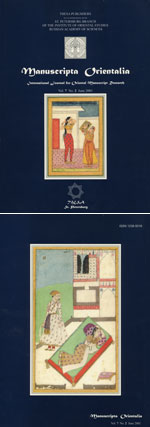|
|
| |

|

|
Vorobyova-Desyatovskaya M. A Sanskrit Manuscript on Birch-Bark from Bairam-Ali. II. Avadāna and Jātaka (Part 3) // Manuscripta Orientalia. Vol. 7. No. 2. June 2001. P. 10—19.
The discussion on the correlation between the Buddhist schools of the Sarvāstivāda and Mūlasarvāstivāda and their disciplinary codes — the Vinaya — began in the 1850s; today, it has entered a new phase, with new facts, manuscripts, and scholars. Fumio Enomoto, a Japanese scholar from Osaka, recently published an article in which he expressed yet another view on the correlation between these two schools. He bases his views on Tibetan and Chinese translations of Vinaya commentaries not preserved in Sanskrit. It is generally known (and recognized by all) that in the ninth century A.D. the Vinaya of the Mūlasarvāsti-vādins was translated into Tibetan, and the Vinayas of the Sarvāstivādins (Shi-song-lü, Taishō, No. 1435) and that of Mūlasarvāstivādins (Taishō, Nos. 1442—1459) was translated into Chinese, too. The Chinese translation was carried out in the seventh century A.D. Fumio Enomoto tried to prove that for Tibetan and Chinese translators the word mula (“root”) held no significance in the titles of the texts they translated and was often omitted. But if translators omitted it, it was probably absent in the Sanskrit original. Enomoto formulated his conclusion as follows: “... it is obvious that both ... ‘Mūlasarvāstivāda’ sect and ... ‘Sarvāstivāda’ (sect) indicate the identical sect... The ‘Mūlasarvāstivāda’ sect does not exist apart from the ‘Sarvāstivāda’ sect. It does not matter whether or not the word ‘mula’ is present”.
Since the core of the Vinaya of all Buddhist schools — the Prātimokşa-sūtra — remained unchanged, although it was preserved in several redactions, the Vinayas of various schools could differ only in their commentaries. Chinese translators, who made special journeys to India for Sanskrit texts and used texts brought to East Turkestan by pilgrims, likely used for their translations commentaries on various parts of the Prātimokşa-sūtra from various regions of Northern India. The latter fact is especially important for the study of the manuscript from Bairam-Ali discussed in this article.
We return to the origins of the various schools’ Vinayas, recalling Étienne Lamotte's view on the matter. He cited in this regard a passage from Chinese translation of the Sanskrit Anuparīndanā (Ta-chih-tu-lun, trans, by Kumārajīva, A.D. 5th century, Taishō, No. 1509), which has not come down to us in the original. The same quote is cited by Enomoto in his article. This passage does not so much clarify the correlation between the Vinayas of the two schools as it provides information about their content: “L’exposé abrégé (sic!) du Vinaya est en 80 sections et les textes du Vinaya sont de deux sortes: 1. Le Vinaya du pays de Mathurā qui avec ses Avadāna et ses Jātaka compre 80 section; 2. Le Vinaya du pays de Kaśmīr qui a rejeté les Jātaka et Avadāna: celui-ci n'a pris que l'essentiel et compte seulment 10 sections. Mais il y a une Vibhāsā en 80 sections qui le commente”. Clearly, these are the “10 sections” that have come down to us in Chinese translation, Shi-song-lü, where there are, in fact, no avadānas and jātakas. This Chinese text suggests that in the Bairam-Ali manuscript the Vibhāsa — a commentary on rules in the form of avadānas and jātakas — follows the brief collection of rules included in the Shi-song-lü.
Of special interest to us is a recent article by Prof. Akira Yuyama (Tokyo) on the Mahāvastu (Mv) and Mahāvastu-Avadāna (MvAv), another collection that contains avadānas and jātakas from the Vinaya of a different school, that of the Mahāsāmghika-Lokottaravādins. Akira Yuyama holds that the Mahdvastu, a work that has not come down to us in Sanskrit, although what has come down to us was published by Emil Senart as early as 1882—1897, is the Mahāvastu-Avadāna, that is, commentaries on the Vinaya in literary form. He writes: “In short, Mv was most probably a Vinaya text once upon a time and MvAv is narrative literature in a very wide sense within the framework of the Vinaya literature in its present form”. In this regard, an interesting conclusion was made by Akira Yuyama: “...every school must have had a similar kind of literature with a strong affiliation to the Vinaya literature”. This once again confirms our view that the Bairam-Ali manuscript contains a “literary” text that explains the Vinaya of the Sarvāstivādins...
К содержанию выпуска...
 PDF-файлы PDF-файлы
Полный текст статьи
Ключевые слова
аваданы
виная
джатаки
коллекция ИВР РАН: издания
коллекция ИВР РАН: переводы
коллекция ИВР РАН: факсимиле
муласарвастивада
рукописи санскритские
сарвастивада
фонд сериндийский
|
|
|
|
Случайная новость: Объявления |
|
7 февраля 2024 г. (в среду) в 17.30 Лекторий ИВР РАН приглашает на лекцию А.Э. Терехова «Образ дракона в культуре Китая». |
|
Подробнее...
|
|
|
|
|

